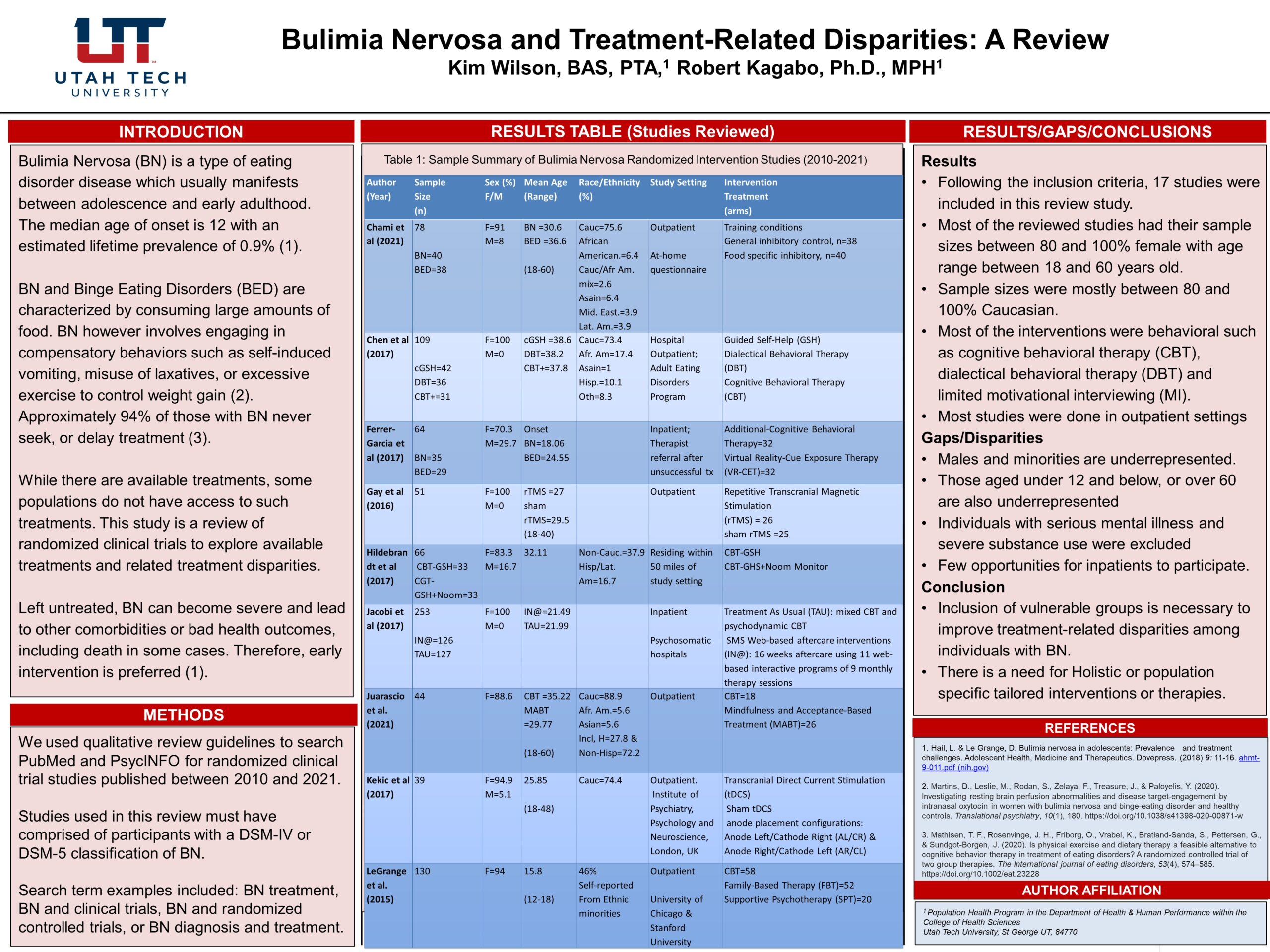Presenter Name: Kim Wilson
Description
Introduction
Bulimia Nervosa (BN) is a type of eating disorder disease which usually manifests between adolescence and early adulthood. The median age of onset is 12 with an estimated lifetime prevalence of 0.9%. BN is characterized by individuals' excessive eating of large amounts of food such as binge eating. The individuals then follow the eating episodes by engaging in unusual compensatory behavior such as self-induced vomiting, misuse of laxatives, or excessive exercise in efforts to control weight gain. There are two types of BN, the purging, and the non-purging type. Research shows that approximately 94% of those with BN never seek or delay treatment. While there are available treatments, it is thought that some populations may not have access to such treatments. This study is a review of clinical trials to explore available treatments and related treatment disparities. Methods
This study followed qualitative review guidelines to review clinical trial studies of BN published between 2010 and 2021. The authors used PubMed and PsychInfo databases to search for articles meeting the inclusion criteria. Search terms included phrases such as, BN treatment, BN and clinical trials, BN and randomized clinical trials, or BN diagnosis and treatment. Any studies that did not involve clinical trials and treatment of BN were excluded from the review. Results
Following the inclusion criteria, 15 studies were included in this review study. Most of the reviewed studies had their sample sizes between 80 and 100% female with age range between 18 and 60 years old. Sample sizes were mostly between 80 and 100% white. Treatment practices included both pharmacological and psychosocial interventions. Majority of the psychosocial interventions were, cognitive behavior therapy and limited motivational interviewing. Conclusion
While all in the general population face risks of developing BN, the reviewed research show that certain groups of populations face disparities in BN treatment. The 12-17, and older than 60 age groups are mostly excluded from research. Males and racial minorities are also excluded. Researchers and practitioners need to include these vulnerable groups to improve treatment-related disparities among individuals with BN.
Bulimia Nervosa (BN) is a type of eating disorder disease which usually manifests between adolescence and early adulthood. The median age of onset is 12 with an estimated lifetime prevalence of 0.9%. BN is characterized by individuals' excessive eating of large amounts of food such as binge eating. The individuals then follow the eating episodes by engaging in unusual compensatory behavior such as self-induced vomiting, misuse of laxatives, or excessive exercise in efforts to control weight gain. There are two types of BN, the purging, and the non-purging type. Research shows that approximately 94% of those with BN never seek or delay treatment. While there are available treatments, it is thought that some populations may not have access to such treatments. This study is a review of clinical trials to explore available treatments and related treatment disparities. Methods
This study followed qualitative review guidelines to review clinical trial studies of BN published between 2010 and 2021. The authors used PubMed and PsychInfo databases to search for articles meeting the inclusion criteria. Search terms included phrases such as, BN treatment, BN and clinical trials, BN and randomized clinical trials, or BN diagnosis and treatment. Any studies that did not involve clinical trials and treatment of BN were excluded from the review. Results
Following the inclusion criteria, 15 studies were included in this review study. Most of the reviewed studies had their sample sizes between 80 and 100% female with age range between 18 and 60 years old. Sample sizes were mostly between 80 and 100% white. Treatment practices included both pharmacological and psychosocial interventions. Majority of the psychosocial interventions were, cognitive behavior therapy and limited motivational interviewing. Conclusion
While all in the general population face risks of developing BN, the reviewed research show that certain groups of populations face disparities in BN treatment. The 12-17, and older than 60 age groups are mostly excluded from research. Males and racial minorities are also excluded. Researchers and practitioners need to include these vulnerable groups to improve treatment-related disparities among individuals with BN.
University / Institution: Utah Tech University
Type: Poster
Format: In Person
Presentation #D44
SESSION D (3:30-5:00PM)
Area of Research: Health & Medicine
Email: kmowilson@gmail.com
Faculty Mentor: Robert Kagabo

